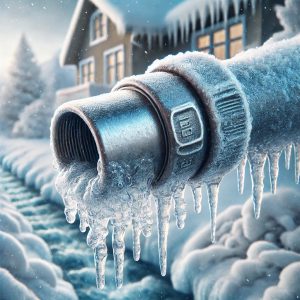
When temperatures plummet close to 0°F, homeowners face the risk of frozen pipes, a common but preventable issue. Frozen pipes can lead to costly repairs, water damage, and significant inconvenience. The good news is that with a few proactive steps, you can protect your plumbing system and keep your home safe during extreme cold. Here’s how:
1. Keep the Heat On
Even if you’re away, maintain your thermostat at a minimum of 55°F. A steady indoor temperature ensures that pipes, especially those located in unheated areas, remain warm enough to prevent freezing.
2. Open Cabinet Doors
In kitchens and bathrooms, open cabinet doors to allow warm air to circulate around pipes located under sinks. This is especially important for plumbing along exterior walls.
3. Insulate Exposed Pipes
Pipes in unheated areas, such as basements, crawl spaces, attics, and garages, are most at risk. Wrap these pipes with foam pipe insulation or heat tape to provide an extra layer of protection against freezing temperatures.
4. Let Faucets Drip
Allowing a slow trickle of water to flow from faucets connected to vulnerable pipes can help prevent freezing. Moving water is less likely to freeze, and this small step can relieve pressure that might otherwise build up in frozen pipes.
5. Seal Cracks and Gaps
Inspect your home for cracks or gaps around windows, doors, and the foundation. Seal these areas with caulk or weatherstripping to keep cold air out and maintain a consistent indoor temperature.
6. Disconnect Outdoor Hoses
Remove and store garden hoses, then close the shutoff valve for outdoor faucets. Drain any remaining water in the lines to prevent freezing and potential bursts.
7. Use Heating Devices Cautiously
If you notice an exposed pipe in danger of freezing, you can use a space heater in the area or wrap the pipe with an electric heating pad. Always follow safety guidelines and never leave these devices unattended.
8. Know the Location of Your Main Water Shut-Off Valve
In case a pipe does freeze and burst, knowing how to quickly shut off the water can minimize damage. Locate your main water valve and ensure it’s operational.
9. Winterize Vacant Homes
For properties that will be unoccupied during freezing weather:
- Shut off the water supply.
- Drain the plumbing system by opening faucets and flushing toilets.
- Consider adding antifreeze to drain traps to prevent freezing.
10. Monitor Weather Conditions
Stay informed about weather forecasts and prepare your home ahead of extreme cold spells. Early preparation can make all the difference.
What to Do If a Pipe Freezes
If you suspect a pipe has frozen:
- Turn on the faucet to relieve pressure.
- Contact a professional plumber if you’re unable to thaw the pipe or if you notice any leaks.
By taking these preventive steps, you can safeguard your home from frozen pipes and the headaches they cause. A little preparation goes a long way toward protecting your investment and ensuring peace of mind during the coldest months.
Need more home maintenance tips or real estate advice? Feel free to reach out—I’m here to help!


 Facebook
Facebook
 X
X
 Pinterest
Pinterest
 Copy Link
Copy Link

